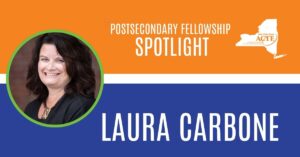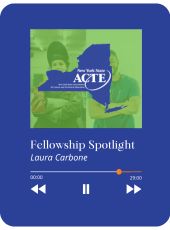
When Laura Carbone saw one of her former preschool students cross the stage at their college graduation, it wasn’t just a proud moment—it was the culmination of nearly two decades of advocacy. Years earlier, Laura had supported that student in preschool and now, after years of wraparound services, assistive strategies, and relentless support, they entered the workforce as a credentialed professional.
That long arc—from preschool to professional—says everything about Laura’s approach: patient, intentional, and rooted in systems designed to stay with you.
Now, as an NYSACTE Postsecondary Fellow, she’s building a model to make that kind of support not the exception—but the standard.
The Personal Story Behind the Mission
Laura’s work is shaped as much by her professional background as it is by her personal life. As a mother of two sons with differing abilities, she has seen firsthand what inclusive systems make possible—and what happens when those systems fall short.
When her son, who has cerebral palsy, enrolled in a local AutoCAD program through BOCES, the team worked closely with Laura to provide the right accommodations, integrate assistive technology, and modify instructional pacing–and by the end of the year, he was recognized by the program as Most Improved Student. The result?
That recognition wasn’t about overcoming a limitation–it was about what became possible when the learning environment finally met his needs. That moment, and others like it, helped shape her leadership philosophy. Whether working as a special education teacher, a program administrator, or now as a director of joint programs at Jefferson Community College and SUNY Potsdam, Laura always comes back to this core belief: students don’t need to be “fixed”—systems do.
Building an Ecosystem: The Compass Model
As part of the NYSACTE Postsecondary State CTE Leaders Fellowship at Advance CTE sponsored by ECMC Foundation, Laura is leading the expansion of the Compass Model, a systematic framework designed to support underrepresented and nontraditional learners in advanced CTE pathways.
So what is the Compass Model?
“It’s about building forward progress for students,” Laura explains. “And at the same time, supporting the educators, institutions, and employers who help guide them.”
The model centers on:
- Communities of practice that break down silos and foster collaboration
- Multi-tiered systems of support modeled after best practices in special education
- Seamless pathways from middle school through employment–dual enrollment, apprenticeships, and micro-credentials
- Policy and infrastructure alignment that makes wraparound services sustainable—not dependent on one champion or one grant
Compass is already being integrated into SUNY Potsdam’s joint programs with Jefferson Community College, and Laura hopes it will serve as a scalable model across New York State.
But more than a new initiative, Laura describes the Compass Model as an ecosystem. “It’s not just about programs,” she says. “It’s about the systems that support people. If we build that well, we retain students, graduate them, and prepare them for jobs where they can thrive.”
Why It Matters–Now More Than Ever
Across the U.S., students with disabilities and adult learners face disproportionately high barriers to credential completion and job placement. Meanwhile, industries are facing labor shortages they can’t afford to ignore.
“We have the employers. We have the people. What we need is coordination,” Laura says.
She’s quick to point out that this isn’t just about equal access—it’s about economics. The systems we build now will determine whether we meet the needs of a future workforce that’s more diverse, more mobile, and in greater need of flexibility than ever before. Laura emphasizes that these interventions aren’t charity—they’re strategy.
From Pilots to Proof
One of Laura’s clearest indicators of impact isn’t found in a spreadsheet—it’s in a student’s story. A young man with a history of special education services who enrolled in her program and struggled to ask for help. Over time, thanks to built-in mentorship, tutoring, and access to basic resources like food and emergency tech support, he began to thrive.
“He went from silent to self-advocating,” she recalls. “And that’s what keeps people in the pipeline—not just ability, but feeling supported enough to stay.”
While Compass is still being piloted, its early results—increased retention, engagement, student satisfaction—suggest a framework with potential far beyond Northern New York.
Policy, Partnerships, and Possibility
Laura believes the next step for Compass isn’t a single campus—it’s a systemwide adoption strategy.
She envisions New York’s SUNY campuses and community colleges embedding the model within existing policy frameworks, including federal funding streams and state equal access initiatives. She also sees employers playing a key role through supported employment programs, flexible training design, and inclusion-focused onboarding.
And critically, she believes in the power of roundtables—spaces where collaborators can align not just on ideas, but on implementation.
“We’ve got the workers. We’ve got the employers. We even have the funding,” she says. “What we need is coordination—and courage.”
From Awareness to Action: A Message for World Autism Day
As a parent of a child with autism and a longtime advocate, Laura sees April’s World Autism Day not as a time for reflection—but a call to action.
For her, the day represents a shift from awareness to acceptance—a theme echoed throughout her Compass Model. It’s about building programs and pathways that recognize the strengths neurodiverse individuals bring to classrooms, campuses, and workplaces.
“Awareness is knowledge,” Laura says. “But acceptance is action. And action is what changes systems.”
This project, and the broader work of the NYSACTE Postsecondary Fellowship, is a step toward that kind of action.
Want More?
| Hear Laura’s full story—and the thinking behind the Compass Model—on her episode of the NYSACTE Fellowship Podcast on Spotify and Apple Podcasts.Explore the work of NYSACTE’s Postsecondary Fellows and how you can join the conversation at nysacte.org. |  |





